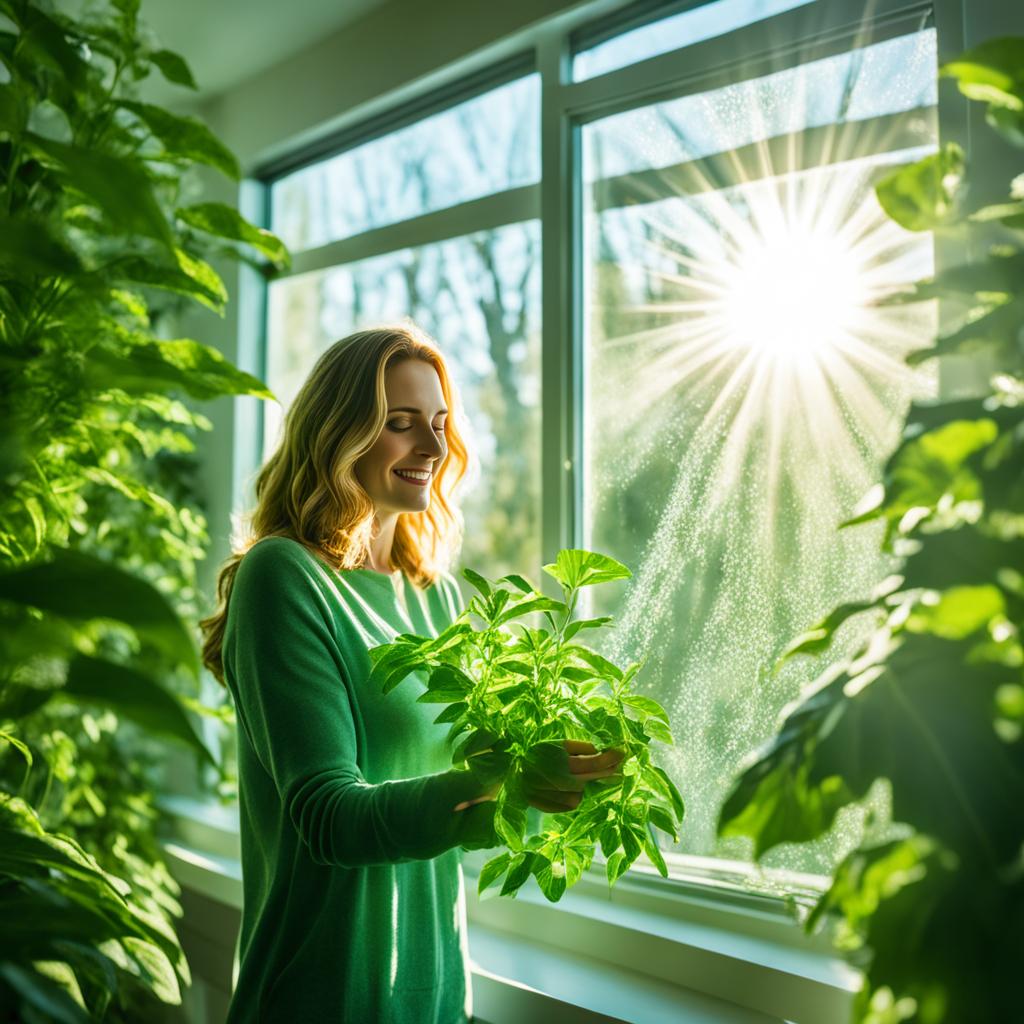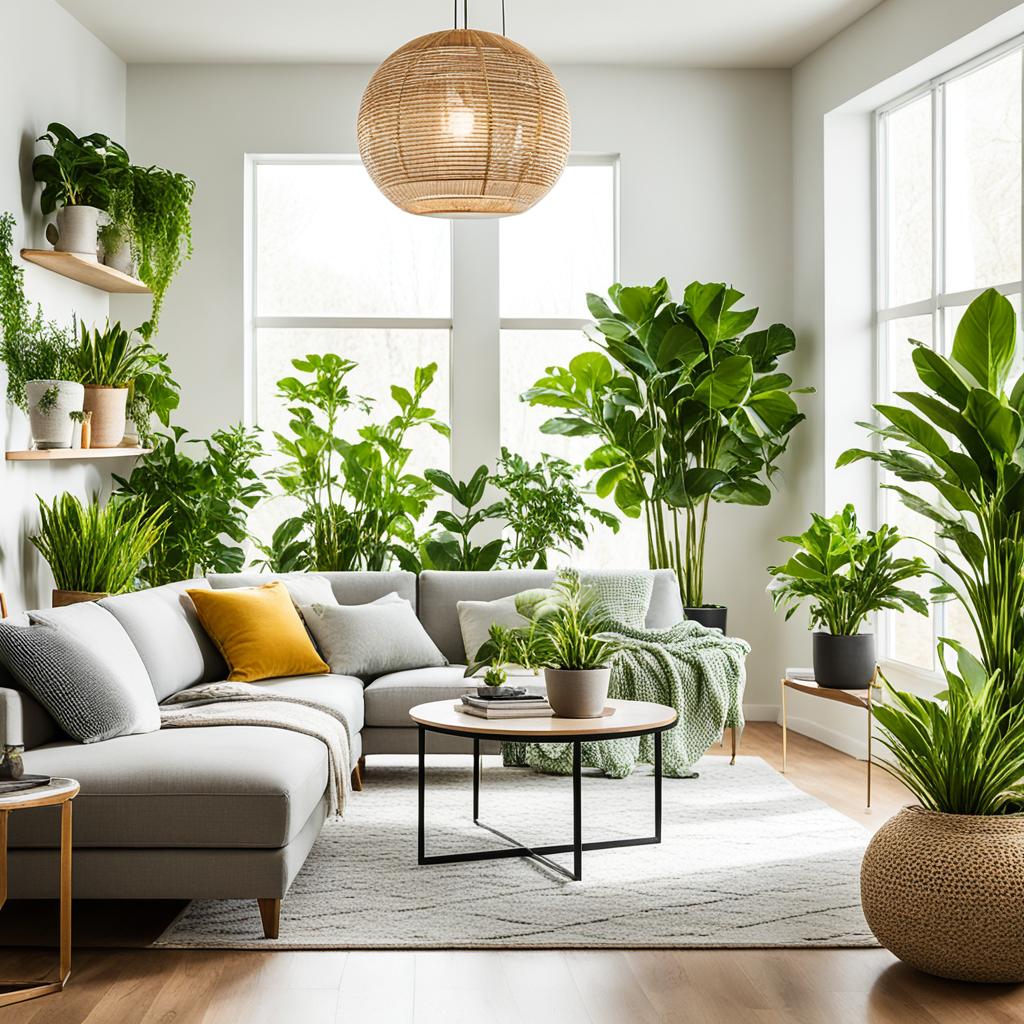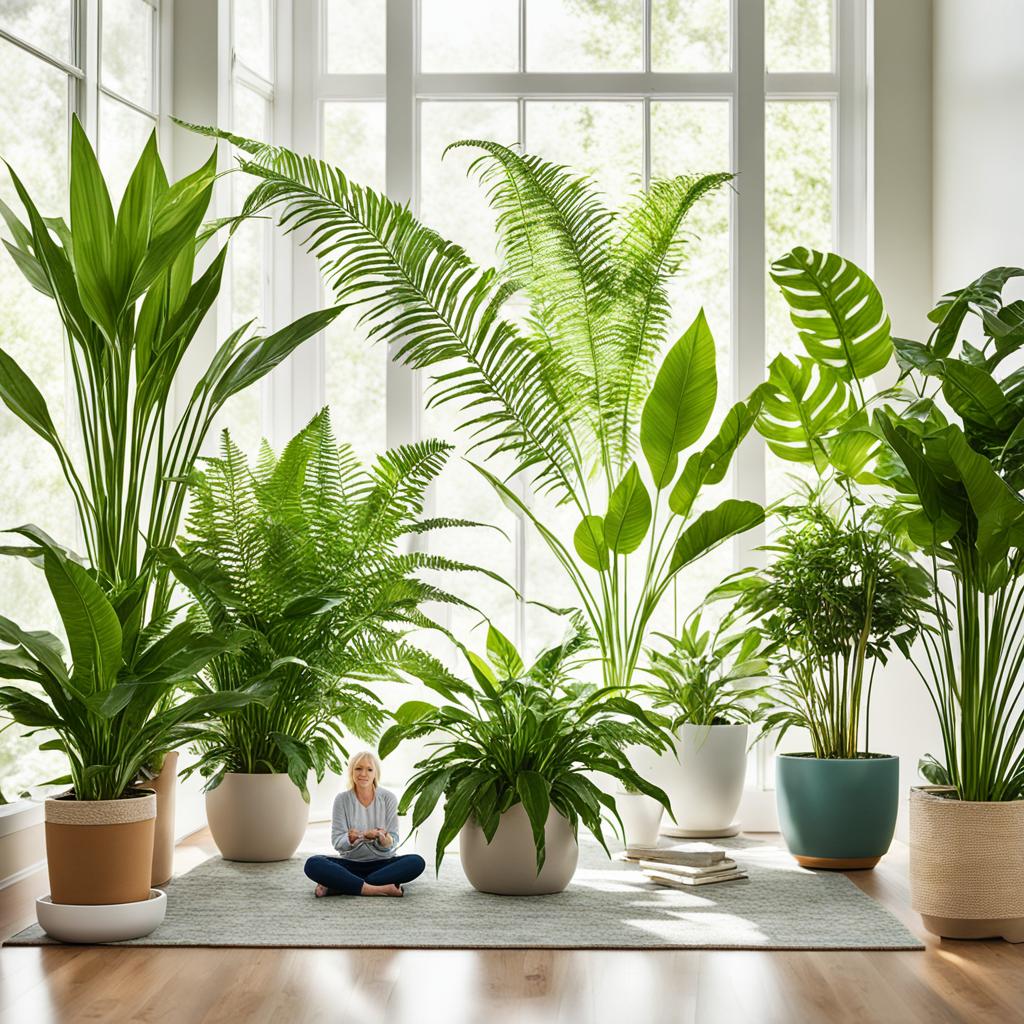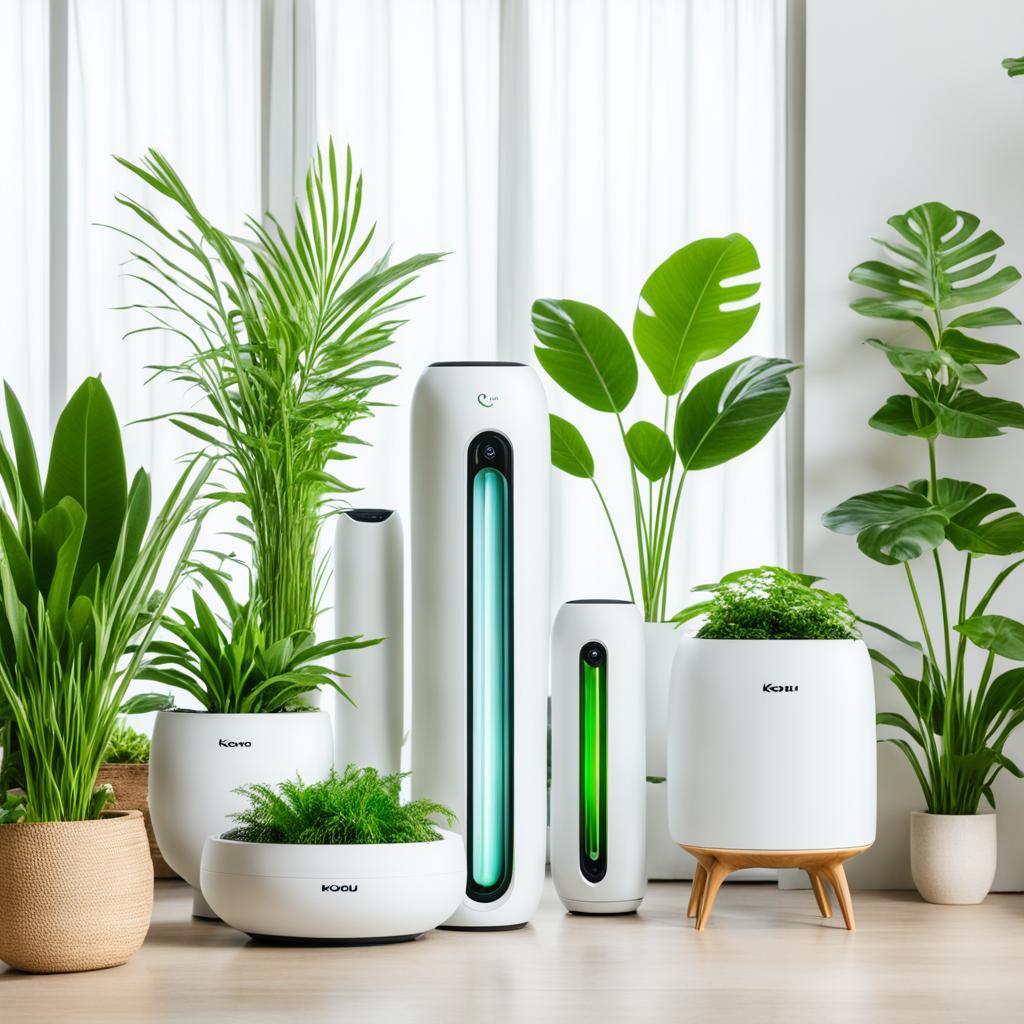Indoor plant sales have soared by 7% yearly since 2021. This growth stems from their air-purifying abilities. These green guardians do more than beautify; they actively improve home air quality.
Air purifying plants offer a natural approach to pollution control. They absorb harmful particles and release oxygen. Larger leaf surfaces clean air more efficiently, making some houseplants true green living champions.
Various plant air filters exist, from exotic Alocasia imperialis ‘Nebula’ to hardy Spider Plants. Each brings unique charm and air-cleaning skills to your home. These natural purifiers can create a healthier, greener home environment.
Key Takeaways
- Indoor plant sales have increased by 7% annually since 2021
- Air purifying plants work as natural air filters in homes
- Larger leaf surface area correlates with better air-cleaning efficiency
- Plants like Alocasia imperialis and Spider Plant are effective air purifiers
- Incorporating houseplants promotes green living and improved air quality
The Science Behind Air Purifying Plants
Indoor air pollution is a serious issue. Americans spend up to 90% of their time indoors. In these spaces, pollutant levels can be five times higher than outdoors.
Air purifying plants offer a natural solution. They can improve air quality in our homes and offices.
NASA’s Clean Air Study
In 1989, NASA conducted a groundbreaking Clean Air Study. It showed plants can be cost-effective air cleaners. They can remove cancer-causing compounds like formaldehyde and benzene from indoor air.

How Plants Filter Air
Plants are nature’s air purifiers. Through photosynthesis, they absorb carbon dioxide and other airborne pollutants. This process cleanses the air we breathe.
Some plants are especially effective. Peace lilies and florist’s chrysanthemums can reduce levels of harmful indoor pollutants.
Benefits of Indoor Air Purification
Indoor plants do more than clean air. They can remove indoor ozone, though modestly. Plants also boost mood, reduce stress, and increase creativity.
A 2020 study found green walls improve building health. For best results, use two large plants per 100 square feet.
Plant effectiveness may vary at home compared to labs. For specific air concerns, combine plants with HEPA air purifiers.
Top Air Purifying Indoor Plants for Your Home
Indoor air can be 2-5 times more polluted than outdoor air, according to the EPA. We spend about 90% of our time indoors. This makes air-cleaning plants crucial for our homes.
Let’s explore some of the best air-purifying houseplants. These green helpers can create a healthier living space for you and your family.

Air-purifying plants are both beautiful and functional. The NASA Clean Air Study identified several plants that effectively capture common pollutants. Here are some top picks:
- Spider Plant: Known for its resilience, this low-maintenance greenery thrives in various environments.
- Peace Lily: Ideal for humid, low-light areas, it removes multiple toxins including ammonia and benzene.
- Snake Plant: This hardy plant releases oxygen at night, making it perfect for bedrooms.
- Boston Fern: Excellent at eliminating pollutants from cigarette smoke to benzene.
- Golden Pothos: Nicknamed “devil’s ivy,” it’s one of the most effective air purifiers.
Experts suggest keeping at least two good-sized plants per 100 square feet. Larger plants generally absorb more toxins. This helps create optimal air purification in your home.
| Plant Name | Light Needs | Toxins Removed | Pet-Friendly |
|---|---|---|---|
| Spider Plant | Moderate to Indirect | Formaldehyde, Xylene | Yes |
| Peace Lily | Low to Moderate | Ammonia, Benzene, Formaldehyde | No |
| Snake Plant | Low to Bright | Benzene, Formaldehyde, Trichloroethylene | No |
| Boston Fern | Moderate to Bright | Formaldehyde, Xylene | Yes |
| Golden Pothos | Low to Moderate | Benzene, Formaldehyde, Xylene | No |
Adding these plants to your home can create a healthier, more vibrant space. Consider your lifestyle, available light, and pet safety when choosing your green companions.
Selecting the Right Air Purifying Plants for Your Space
Picking air purifying plants requires careful thought about room size and light conditions. Let’s explore how to match plants to your lifestyle. We’ll also find pet-friendly options for a healthier home.
Room Size and Light Conditions
When choosing plants, think about your space size. Large rooms need bigger plants like the Bamboo Palm, which grows up to 12 feet tall. Smaller areas do well with compact options such as the Spider Plant.
For effective air cleaning, use at least two plants per 100 square feet. Light conditions are key for plant health and air-purifying power. The Philodendron Heartleaf thrives in various light settings.
Rooms with indirect sunlight benefit from the Dwarf Date Palm. It’s an excellent choice for these spaces.

Matching Plants to Your Lifestyle
Busy people need low-maintenance air purifiers. The Snake Plant is perfect, surviving weeks of neglect while removing toxins. For offices, try the Chinese Evergreen.
It tolerates poor light and dry air well. This makes it ideal for work environments.
Pet-Friendly Options
Pet owners should choose safe air purifying plants. The Spider Plant cleans air effectively and is safe for cats and dogs. Avoid Peace Lilies, as they’re toxic to pets.
Hanging plants like English Ivy keep greenery away from curious pets. They also purify the air in your home.
| Plant Name | Air Purifying Ability | Pet-Friendly | Light Requirement |
|---|---|---|---|
| Spider Plant | Removes formaldehyde, xylene | Yes | Indirect light |
| Bamboo Palm | Filters formaldehyde, benzene | Yes | Bright indirect light |
| Snake Plant | Removes VOCs | Mildly toxic | Low to bright light |
Consider these factors to create a healthier indoor space. Choose air purifying plants that fit your room, lifestyle, and pet needs.
Caring for Your Air Purifying Plants
Proper care keeps air purifying plants healthy and effective. Each plant has unique watering needs. Snake Plants need less water, while Peace Lilies prefer consistent moisture.
Most air purifying plants thrive in well-draining soil. This prevents root rot and ensures optimal growth. Pay attention to your plant’s specific soil requirements.
Fertilizer boosts growth during growing seasons. Use a balanced, water-soluble fertilizer every 4-6 weeks for lush foliage plants like Philodendron. Humidity control matters too. Rubber Plants love high humidity, but Dracaenas adapt easily.

Temperature affects plant health. Most indoor plants prefer 60-75°F (15-24°C). Keep them away from drafts and heat sources. Good care keeps plants alive and boosts their air-cleaning power.
| Plant | Watering Needs | Light Preference | Humidity Level |
|---|---|---|---|
| Snake Plant | Low | Low to Bright Indirect | Low to Medium |
| Peace Lily | Medium | Low to Bright Indirect | High |
| Spider Plant | Medium | Bright Indirect | Medium |
| Boston Fern | High | Bright Indirect | High |
Meet these care needs to help your air purifying plants thrive. They’ll reward you by improving your indoor air quality effectively.
Maximizing Air Purification with Plant Placement
Clever plant placement can significantly improve air quality in your home. By positioning your green allies strategically, you’ll create a cleaner, healthier living space.
Strategic Positioning for Optimal Results
Position air-purifying plants where pollutants are most concentrated. Kitchens, bathrooms, and areas near electronics are ideal spots. The EPA states indoor air can be five times more polluted than outdoor air.

Creating Plant Clusters
Grouping plants together enhances their air-cleaning abilities. These clusters act as natural air filters, tackling various indoor pollutants. Try pairing a Snake Plant with a Peace Lily for a powerful purifying duo.
Combining Plants with Other Air Purification Methods
Boost your air purification by combining plants with other methods. An air filter design using plants and activated carbon can maximize pollutant removal. This approach aligns with NASA’s research on plants as air purifiers.
- Dust plant leaves regularly to maintain efficiency
- Monitor soil moisture for optimal plant health
- Rotate plants to ensure even growth and light exposure
- Use plant ties or support poles for larger plants to maximize surface area
A diverse selection of air-purifying plants targets many pollutants. These strategies will help create a healthier indoor environment. Léon & George’s Plant Doctor service offers expert advice to keep your green air purifiers thriving.
Beyond Air Purification: Additional Benefits of Indoor Plants
Indoor plants do more than clean air. They transform living spaces and boost wellbeing. These green companions offer mood enhancement and natural decor.
Spider Plants and Snake Plants purify air and reduce stress. They create a calming atmosphere for relaxation. The Peace Lily adds elegance while tackling indoor pollutants.

Boston Ferns excel in humidity control and air purification. They’re ideal for bathrooms or kitchens. Rubber Plants make bold statements while filtering formaldehyde.
Indoor plants can spark creativity in work spaces. The Bamboo Palm adds tropical flair and removes harmful chemicals. It’s perfect for home offices, inspiring ideas and improving focus.
| Plant | Air Purification | Additional Benefits |
|---|---|---|
| Aloe Vera | Removes formaldehyde and benzene | Skin-healing properties |
| Snake Plant | Filters benzene, formaldehyde, trichloroethylene | Emits oxygen at night, improves sleep |
| Peace Lily | Removes ammonia, benzene, formaldehyde | Enhances room aesthetics |
| Boston Fern | Filters formaldehyde and xylene | Increases humidity, ideal for dry spaces |
These versatile plants improve air quality and create natural decor. They promote wellbeing, reduce stress, and enhance your home’s appeal. Adding them to your space brings multiple benefits.
Innovative Air Purification Solutions: The KORU Plant-Inspired Purifier
The KORU air purifier offers a fresh take on indoor air quality. It blends plant-inspired tech with smart purification for cleaner home air. This unique device provides an effective solution for better breathing.
Features and Benefits of KORU
KORU’s washable photocatalytic filter sets it apart. It tackles VOCs, mold, odors, allergens, and dust effectively. KORU mimics nature’s air-cleaning process, making it both powerful and eco-friendly.

Integrating Technology with Natural Air Purification
KORU uses artificial intelligence to enhance its performance. It analyzes plant needs and adjusts growth conditions for best results. This smart approach ensures top-notch natural air purification at all times.
Smart Monitoring for Optimal Plant Health and Air Quality
KORU’s six high-tech sensors track VOCs, temperature, humidity, and light exposure. This data helps maintain ideal conditions for air cleaning and plant health. Users can access this info through a simple mobile app.
- Tracks VOCs, temperature, humidity, and light
- Uses AI to optimize plant growth and air purification
- Features a user-friendly mobile app for easy monitoring
KORU merges nature with advanced tech for better air quality. It’s a smart pick for those wanting cleaner air at home. This powerful tool offers an effective, sustainable way to breathe easier.
Troubleshooting Common Issues with Air Purifying Plants
Air purifying plants can face several care issues. Yellowing leaves often signal overwatering or light exposure problems. Check soil moisture before watering and ensure plants get appropriate light.
Pest control is crucial for healthy plants. Inspect leaves regularly for infestation signs. Use natural remedies or insecticidal soaps to treat pest problems.

Overwatering can lead to root rot and mold growth. This harms the plant and may trigger allergies. Ensure proper drainage and let soil dry between waterings.
| Issue | Cause | Solution |
|---|---|---|
| Yellowing Leaves | Overwatering, Poor Light | Adjust Watering, Relocate Plant |
| Pest Infestation | Poor Plant Health, Contamination | Natural Remedies, Insecticidal Soap |
| Mold Growth | Overwatering, Poor Ventilation | Reduce Watering, Improve Air Flow |
Professional plant care services can help maintain optimal plant health. They’re useful for busy individuals who want efficient air-purifying plants. However, proper ventilation and air cleaning methods are more effective for reducing indoor pollution.
Conclusion
Air-purifying plants naturally improve indoor air quality. Peace lilies, Rubber plants, and Snake Plants remove harmful chemicals from our homes. These green friends beautify our spaces and promote healthy living.
These plants do more than clean air. They reduce stress and boost overall well-being. Bamboo palms add moisture to the air, decreasing harmful chemicals and improving comfort.
Plants are great for air purification. However, they work even better with innovative technologies. The KORU plant-inspired purifier combines nature’s power with smart tech for optimal air quality.
By using these solutions, we create healthier living spaces. These environments support both our physical and mental health. They make our homes more vibrant and enjoyable.
